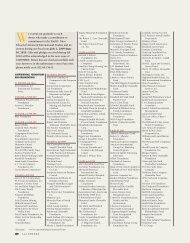Download Current Issue - SAIS
Download Current Issue - SAIS
Download Current Issue - SAIS
Create successful ePaper yourself
Turn your PDF publications into a flip-book with our unique Google optimized e-Paper software.
Year of<br />
Agriculture<br />
at<strong>SAIS</strong><br />
The generally steady evolution of<br />
prices up until the early 2000s came to<br />
be expected as a matter of course. This<br />
sense of complacency was fostered by<br />
a belief in technological progress—<br />
associated in part with overconfidence<br />
in the wake of the “green revolution”<br />
of the 1960s and 1970s and in part<br />
with the international organizational<br />
infrastructure that created a big food<br />
aid industry to supply spots mired in<br />
sudden, acute scarcity. Chief among<br />
these organizations were the United<br />
Nation’s Food and Agriculture Organization<br />
(FAO); the World Bank and<br />
regional multilateral banks, such as<br />
the Inter-American Development Bank,<br />
the Asian Development Bank and the<br />
African Development Bank; and superpower<br />
agricultural producers, including<br />
the United States and some of the<br />
European Union member countries.<br />
Along came the 2000s and with<br />
them two great international agricultural<br />
price shocks. In 2007–08, sudden<br />
price increases in the previously placid<br />
agricultural sector were responsible for<br />
food riots in countries as different and<br />
far apart as Burkina Faso, Egypt, Haiti,<br />
Madagascar, Mexico, Philippines, Senegal<br />
and Yemen.<br />
Scholars, analysts, policymakers,<br />
major agribusiness corporations and<br />
farmers themselves have highlighted<br />
a multiplicity of causes behind the<br />
higher commodity prices.<br />
On the supply side, the oil price<br />
bull-run between 2003 and 2008 hit<br />
agriculture significantly, given its high<br />
contribution to the production cost per<br />
unit in this sector because of fertilizers,<br />
transportation and other industrial<br />
agribusiness operations. Cereal stocks<br />
fell to their lowest levels since the early<br />
1980s. And, specifically in the United<br />
States, growing proportions of the corn<br />
crop were channeled into the production<br />
of ethanol for use in transport.<br />
On the demand side, experts identified<br />
a structural shift in global patterns,<br />
with higher consumption of animal<br />
protein (itself raised through animal<br />
feed based on basic grains) in the big<br />
emerging market countries of Asia<br />
and increasing demand for biofuels to<br />
reduce carbon emissions. The latter<br />
2011–2012 29



